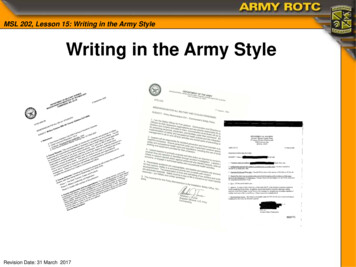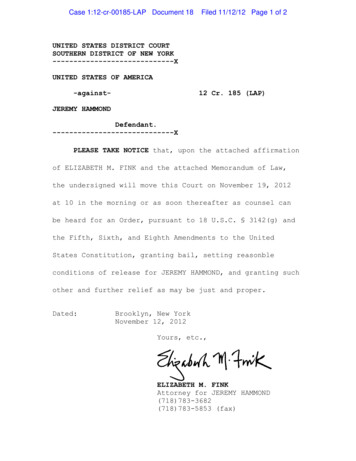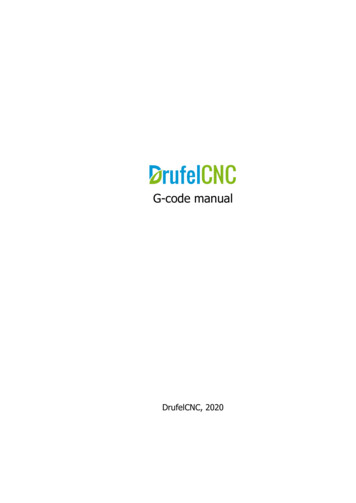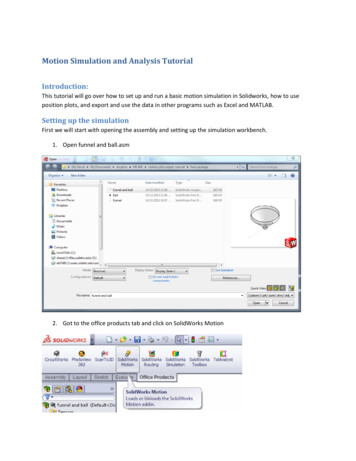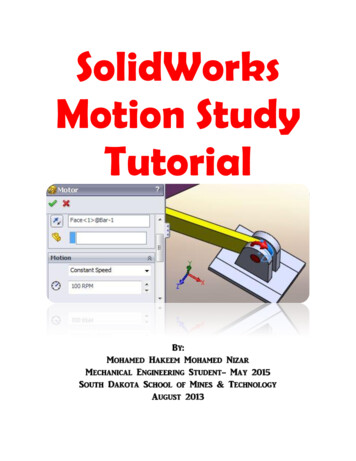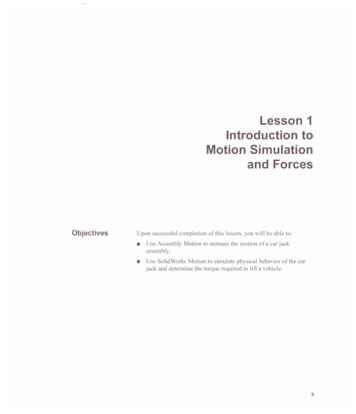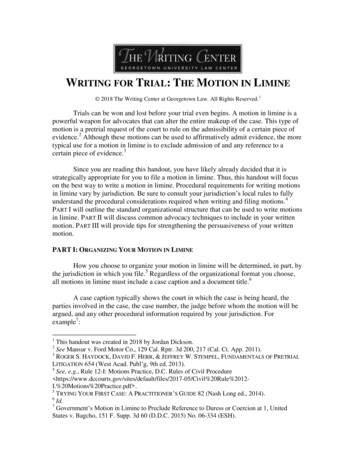
Transcription
WRITING FOR TRIAL: THE MOTION IN LIMINE 2018 The Writing Center at Georgetown Law. All Rights Reserved. 1Trials can be won and lost before your trial even begins. A motion in limine is apowerful weapon for advocates that can alter the entire makeup of the case. This type ofmotion is a pretrial request of the court to rule on the admissibility of a certain piece ofevidence.2 Although these motions can be used to affirmatively admit evidence, the moretypical use for a motion in limine is to exclude admission of and any reference to acertain piece of evidence.3Since you are reading this handout, you have likely already decided that it isstrategically appropriate for you to file a motion in limine. Thus, this handout will focuson the best way to write a motion in limine. Procedural requirements for writing motionsin limine vary by jurisdiction. Be sure to consult your jurisdiction’s local rules to fullyunderstand the procedural considerations required when writing and filing motions.4PART I will outline the standard organizational structure that can be used to write motionsin limine. PART II will discuss common advocacy techniques to include in your writtenmotion. PART III will provide tips for strengthening the persuasiveness of your writtenmotion.PART I: ORGANIZING YOUR MOTION IN LIMINEHow you choose to organize your motion in limine will be determined, in part, bythe jurisdiction in which you file.5 Regardless of the organizational format you choose,all motions in limine must include a case caption and a document title.6A case caption typically shows the court in which the case is being heard, theparties involved in the case, the case number, the judge before whom the motion will beargued, and any other procedural information required by your jurisdiction. Forexample7:1This handout was created in 2018 by Jordan Dickson.See Mansur v. Ford Motor Co., 129 Cal. Rptr. 3d 200, 217 (Cal. Ct. App. 2011).3ROGER S. HAYDOCK, DAVID F. HERR, & JEFFREY W. STEMPEL, FUNDAMENTALS OF PRETRIALLITIGATION 654 (West Acad. Publ’g, 9th ed. 2013).4See, e.g., Rule 12-I: Motions Practice, D.C. Rules of Civil Procedure 05/Civil%20Rule%2012I.%20Motions%20Practice.pdf .5TRYING YOUR FIRST CASE: A PRACTITIONER’S GUIDE 82 (Nash Long ed., 2014).6Id.7Government’s Motion in Limine to Preclude Reference to Duress or Coercion at 1, UnitedStates v. Bagcho, 151 F. Supp. 3d 60 (D.D.C. 2015) No. 06-334 (ESH).2
The document title should simply state what the motion is. For example:MOTION TO SUPPRESS TANGIBLE EVIDENCE, STATEMENTS, ANDIDENTIFICATION EVIDENCEAfter the caption and title, your organizational structure will vary depending onyour own stylistic preferences and the requirements of your jurisdiction. Below is adescription of a standard organizational method typically used.8A. Sample Structure9This organizational structure breaks the body of the motion in limine down intotwo distinct parts: (1) the motion and (2) a memorandum of points and authorities.10 Inthis structure, the motion itself is only a short, bulleted set of statements that state (1) thepiece of evidence the party wishes to exclude/admit and (2) the evidentiary bases uponwhich that evidence should be excluded or admitted.11 If there is more than one issue youwish to address in your motion, include that as a separate bullet point. For example12:8See LONG, supra note 5; MARILYN J. BERGER, JOHN B. MITCHELL, & RONALD H. CLARK,PRETRIAL ADVOCACY: PLANNING, ANALYSIS, AND STRATEGY 410 (Wolters Kluwer Law &Business, 4th ed. 2013).9For an example of an alternative organizational structure for your motion in limine see BERGER,supra note 8, at 412–417. This alternative structure more closely mirrors the standardorganization of an appellate brief and includes a “Relief Requested,” “Statement of the Case,”“Statement of Facts,” “Issue Presented,” “Argument,” and “Conclusion” section.10See LONG, supra note 5, at 82–83.11Id.12United States’ Motion in Limine at 1, United States v. Maloof, No. H-97-93 (S.D. Tex. 1997) tates-motion-limine .
Pursuant to Fed. R. Crim. P. 12(b), and for the reasons set forth in the accompanyingMemorandum, the United States hereby moves that the Court enter an Order:1. Prohibiting the defendant from offering or commenting on the following evidenceon the grounds that it is irrelevant to the charges against him and the fact-findingduties of the jury:a. Evidence related to the punishment that may be provided by law for aviolation of the Sherman Act (15 U.S.C. § 1); and conspiracy to commitwire fraud (18 U.S.C. § 371);The motion itself should be a stand-alone document that includes a signature fromcounsel. Beginning on a new page, you will then address the merits of your argument in asection titled “Memorandum of Points and Authorities.”13 The Memorandum section ofyour motion in limine should be broken into two sections: (1) Factual Background and(2) Argument.The “Factual Background” section of your Memorandum should include all of thefacts necessary for the judge to resolve every issue raised in your motion.14 It can, ifappropriate, include procedural posture, as well. The facts and procedural underpinningscan be presented in standard essay form or as bullet points.15 Keep in mind that motionfilings may be the judge’s first opportunity to hear and react to the facts of the case.16Because of this, you will want to include an overview of the case as a whole whilehighlighting the facts specifically relevant to your motion issues.The “Argument” section of your Memorandum will look similar to other types ofpersuasive legal writing you have likely done. In this section you will be applying thefacts of your case to legal rules and precedent. This section should tell the judge why it islegally appropriate to rule in your favor.17 It should be written in essay format. It wouldbe wise to use separate point headings to distinguish between each piece of evidence youwant the judge to rule on. Likewise you should use separate point headings to separatedifferent legal arguments for each piece of evidence at issue.18The Memorandum should include a conclusion restating what action you want thejudge to take.19 Counsel should sign the Memorandum.B. Additional Parts of Your MotionRegardless of your organizational choice, your motion should be delivered withthe evidence or facts you rely upon as an attachment or appendix.20 This appendix13See LONG, supra note 5, at 82–83.Id. at 83.15Id.16See HAYDOCK ET AL., supra note 2, at 669.17LONG, supra note 5, at 83.18Id.19Id.20Id. at 417.14
material can include affidavits, exhibits, police reports, pictures of tangible evidence, etc.You should cite to this appendix when you write your statement of facts.21Separately, your motion should include a proposed order.22 The proposed ordershould be written so if the judge decides to grant your motion, all she has to do is sign atthe bottom for it to become a court order. How a proposed order should look will vary byjurisdiction. But as an example, a proposed order could look, in part, like this23:SUPERIOR COURT OF THE DISTRICT OF COLUMBIAFamily Division – Juvenile BranchIn the Matter OF J.W.Respondent::Docket No. 2017-DEL-000000Status: November 27, 2017ORDER APPOINTING EDUCATION ATTORNEYUpon consideration the record in this case and after due consideration of theinterests of all parties in the above captioned matter, it is this day of November,2017, herebyORDERED that Kimberly Glassman, is appointed as educational attorney forC.M., mother of J.W. , concerning J.W.’s educational needs, and it isFURTHER ORDERED that Kimberly Glassman is authorized to attend,participate in, and provide reports in connection with any D.C. Superior Courtproceeding;PART II: ADVOCACY TECHNIQUES TO INCORPORATE IN YOUR MOTIONThe facts and/or the law may not always be perfectly on your side when trying acase or when filing a motion in limine. But sometimes you can overcome unfavorablefacts and unfavorable law by using effective advocacy techniques.24 Below you will finda few standard trial advocacy concepts that, if incorporated properly, can help give youthe best chance to have your motion granted.21Id.Id.23Proposed Order Appointing Education Attorney at 1, In re J.W., No. 2017-DEL-1190 (D.C.Super. Ct. 2017).24See LONG, supra note 5, at 25.22
A. Motion TheoryA theory is an “ends-means” analysis targeted at achieving the overall objective.25The “ends” of your overall case is to win the case for your client. The “means” by whichto achieve these ends is the legal argument and factual application required to secure avictory from the judge or jury. In layman’s language, a motion theory fills in the blank inthe statement, “My client will win this case because [insert theory].” The “ends” of yourmotion in limine is for the court to grant your motion. The “means” is the legalmechanism and factual application required to get the court to grant your motion.Typically your motion theory will parallel your case theory, but will be morenuanced and focused on only the issue covered in your motion. Motions, and cases intheir entirety, can falter if the theory is not clear.26 You should ensure you understandyour motion theory and that your motion theory comes across clearly in your writtenproduct. For example, your theory on a motion to suppress could be, “The court shouldgrant my motion to suppress because officers did not have reasonable suspicion to stopmy client and the evidence seized is therefore fruit of an illegal stop.”The statement of the motion theory does not need to appear verbatim in yourmotion. It is only important that the concept of the theory comes across clearly to thejudge so that she understands precisely what you are arguing and the basis for thatargument.B. Motion ThemeEvery motion needs a central, unifying theme in order to be effective.27 A themeis a short statement, phrase, or simply a word that encapsulates the analytic framework ofyour motion.28 But most importantly, a theme is a persuasive hook—somethingmemorable the judge can latch onto that catches her attention. The most classic exampleof a trial theme is “if the glove don’t fit, you must acquit,” from the O.J. Simpson trial.Motion themes will likely not be as trite or casual. Motions, after all, are grounded in lawand argued to a judge, not a jury. But even judges can benefit from attention-grabbingthemes that give them a reason to remember what you wrote or said.As an example, assume you are filing a motion to disqualify an expert witnessunder Daubert and FRE 702 because you do not believe she has any specializedexpertise. Your theme could be something like, “One needs real expertise to be anexpert.” As a standalone statement, this does not add much to your argument nor does it25See BERGER, supra note 8, at 395.Id.27See HAYDOCK ET AL., supra note 2, at 671. Some practitioners refer to this unifying themeconcept as a “theory of the case.” See, e.g., Osamudia Guobadia and Jennifer Pogue, FROMMEMO TO BRIEF, 3–4 load/memotobrief.pdf .28See BERGER, supra note 8, at 405.26
explain any facts. But its purpose is to grab the reader’s attention and to be pithy enoughto use throughout your writing.Your theme should appear early and often in your motion.29 For example, in thebeginning of your statement of the relevant facts you could include your theme. It shouldalso be interwoven throughout your motion, in both the facts and the argument section.30This does not mean that you have to continuously state the “theme statement” over andover again. Interweaving words or phrases that evoke the same meaning and useconsistent phraseology is an effective way of reminding the judge of your theme withoutbeing blatantly repetitive.31 The theme should also be repeated at the end of yourargument.32C. Knowing Your AudienceUnderstanding the audience to which you are writing probably seems like anobvious piece of advice. But when writing a motion in limine, knowing the judge’stendencies can be particularly important.33 Understanding how the judge thinks and reactsto motions on similar subject matter can guide choices you make about the order of yourvarious arguments or about whether to even include a particular argument at all. Forexample, the judge before whom you appear may have, via her decisions or statements,indicated that she will never grant pretrial motions on relevance grounds.34 If thathappens, you can choose to either forego that part of your motion entirely or shift yourargument away from relevance grounds and onto a different evidentiary basis.Talking with other lawyers who have appeared before this judge, observing thejudge during motion arguments, and reading previous decisions on related topics can helpyou frame your argument most effectively.35PART III: PERSUASIVE WRITING TIPS FOR MOTIONSThe final part of this handout addresses tips to make your written motion in liminecompelling, believable, and approachable. Many of these tips are applicable acrossdifferent pieces of legal writing. Regardless, your motion will be improved by attentionto these legal writing tips.29RONALD WAICUKAUSKI, PAUL MARK SANDLER, & JOANNE EPPS, THE WINNING ARGUMENT74 (American Bar Association 2001).30See BERGER, supra note 8, at 425.31See HAYDOCK ET AL., supra note 2, at 671.32WAICUKAUSKI, supra note 37, at 75.33BERGER, supra note 8, at 427.34See LONG, supra note 5, at 84.35Id.
A. StorytellingA judge, like any other person, can be engaged by a well-crafted story.36 Yourmotion in limine will, therefore, be made more compelling by creating a vivid, story-likepicture for the judge to experience.37 Creating a compelling story can be achieved byincluding specific, sensory details that present your characters as developing individualsor entities that the judge has a reason to care about.38 This, of course, does not mean thatyour motion should be a dramatic, hyperbolic work of fiction. But telling a value-based,human story can increase the likelihood that a busy trial judge will take the time tothoroughly read your work.39One classic legal storytelling technique is to use a figurative analogy.40 In thistype of narration, you relate the facts of your case to the elements of the analogy. 41 Forexample, if you believe your opponent has brought a meritless case, you could analogizeto the boy who cried wolf. You could say by bringing meritless cases the governmentjeopardizes people believing the government when it brings genuine cases—similar tohow the boy who cried wolf jeopardized people believing him when he actually saw awolf.42Regardless of how you tell the story, having elements of storytelling can keepyour reader interested and engaged.B. CandorIt is critical in your motions in limine to be candid with the court.43 If youoverstate the evidence, overstate the favorability of the law, or otherwise exercise licensewith the truth you run the risk of the judge beginning to view you, and more importantlyyour arguments, with skepticism.44 It is beneficial often to admit where a fact or a pieceof precedential authority may not be favorable to your side.45Overstating often occurs in the “ask” of the court.46 For example, ending yourmotion by stating, “There is only one possible outcome the Court can reasonably cometo,” is probably an overstatement. It is better to be candid, but still assertive andexpressive in your tone.47 For example, your “ask” would be more reasonable, but still36See BERGER, supra note 8, at 419.WAICUKAUSKI, supra note 37, at 87.38Id.39See BERGER, supra note 8, at 419.40WAICUKAUSKI, supra note 37, at 87–88.41Id.42Id. at 88.43HAYDOCK ET AL., supra note 2, at 671.44WAICUKAUSKI, supra note 37, at 36.45Id. at 36–37.46HAYDOCK ET AL., supra note 2, at 679.47Id.37
assertive, if you said something like, “For the aforementioned reasons, the United Statesurges this Court to exclude Exhibit 11.”C. BrevityAs has been mentioned several times already, trial judges are busy people with alot on their dockets. As such, brevity in a motion can be your best friend. The length ofyour motion should correspond to jurisdictional requirements, but also correspond to thecomplexity of the issue(s) being addressed.48 That said, your motion must give the courtenough factual background and legal authority to understand the evidence in question andthe legal basis for your requested relief.49 Judges will appreciate a complete picture, butwill appreciate if that picture can be conveyed in as succinct a way as possible.50PART IV: EXAMPLEBelow is an excerpt of example motion in limine.5148Id. at 669.LONG, supra note 5, at 81.50Id. at 80.51Jordan Dickson, GOVERNMENT’S MOTION IN LIMINE TO ADMIT CERTAIN EVIDENCE ANDEXCLUDE CERTAIN EVIDENCE, Georgetown University Law Center: Advanced Evidence,Professors Blanco and Mossier, Fall 2017.49
UNITED STATES DISTRICT COURTFOR THE DISTRICT OF COLUMBIAUNITED STATES OF AMERICAv.ZACH LODGE;;;;;Criminal Case No. 14-017GOVERNMENT’S MOTION IN LIMINETO ADMIT CERTAIN EVIDENCE AND EXCLUDE CERTAIN EVIDENCEThe United States of America, by and through counsel, respectfully submits thisMotion In Limine, pursuant to Fed. R. Crim. P. 12(b) and for the reasons set forth in theaccompanying Memorandum, and hereby moves that the Court enter an Order:1. Admitting into evidence Joint Exhibit 10—the February 12, 2014, email fromDavid O’Neil to John Kelly.a. Alternatively, excluding David O’Neil’s testimony in its entirety underFed. R. Evid. 403.2. Denying the defendant’s request for judicial notice that visibility was diminishedon February 11, 2014, under Fed. R. Evid. 201.3. Excluding testimony or evidence that the victims possessed guns when they weremurdered under Fed. R. Evid. 104(b) and Fed. R. Evid. 401.4. Excluding testimony or evidence of prior convictions of victims John Beckwithand Chazz Reinhold under Fed. R. Evid. 404(b).5. Excluding statement of Kathleen Cleary of, “Whether the man I saw running hadshot them in self-defense,” under Fed. R. Evid. 401 and Fed. R. Evid. 802.
6. Excluding testimony of Kathleen Cleary relating to improper character evidenceof the victims under Fed. R. Evid. 404(a) and Fed. R. Evid. 404(b).7. Excluding testimony of Kathleen Cleary relating to a specific instance of priorbad acts by one of the victims under Fed. R. Evid. 404(b) and Fed. R. Evid. 802.Respectfully submitted,Jordan DicksonUnited States Department of Justice
UNITED STATES DISTRICT COURTFOR THE DISTRICT OF COLUMBIAUNITED STATES OF AMERICAv.ZACH LODGE;;;;;Criminal Case No. 14-017MEMORANDUM IN SUPPORT OF GOVERNMENT’S MOTION IN LIMINEThis Memorandum sets forth the reasons for the relief sought in the Motion InLimine.FACTUAL BACKGROUNDThe defendant, Zach Lodge, is charged with two counts of murder in the firstdegree in violation of 18 U.S.C. § 1111 and one count of attempted murder in violation of18 U.S.C. § 1113. On February 11, 2014, the defendant, a convicted felon, shot and killedJeremy Grey and John Beckwith and shot, with the intent to kill, Chazz Reinhold. Thedefendant shot the victims during a drug transaction on the corner of 2nd and E StreetNW. The victims owed the defendant in excess of 5,000. An argument ensued. Thedefendant, in a premeditated fashion, murdered Mr. Grey and Mr. Beckwith andattempted to murder Mr. Reinhold.Kathleen Cleary, a citizen of D.C., heard the gunshots and saw the defendant fleefrom the scene. Police, using a K-9 unit, recovered the defendant’s M&P9 handgun.Expert analysis concluded lip prints found on this gun match the defendant’s lip prints.An anonymous 911 call came from an apartment located at 595 3rd Street NW.Police surveilled this apartment owned by David O’Neil. Ten days after the murders,police saw the defendant inside. Police executed legally operative arrest and search
warrants at O’Neil’s residence. They arrested both the defendant and O’Neil. Policerecovered a box of forty-five 9mm bullets. These bullets, upon testing by an FBImaterials expert, had the same metallic composition of the bullets used to murder thevictims. Police also recovered an email sent by O’Neil implicating the defendant in themurders and implicating O’Neil in the cover up.ARGUMENT1. The Court should admit into evidence Joint Exhibit 10—an email from David O’Neil toJohn Kelly—or alternatively exclude David O’Neil’s testimony in its entirety.The Court should admit Joint Exhibit 10. It is an email from David O’Neil to JohnKelly. This email implicates O’Neil’s involvement in covering up the defendant’s crimesand implicates the defendant in the commission of those crimes. The email is relevantand easily authenticated. It is not barred by hearsay or privilege. If the Court excludesJoint Exhibit 10, it should exclude David O’Neil’s testimony in its entirety pursuant toFed. R. Evid. 403.a) Joint Exhibit 10 is relevant to the defendant’s commission of this crime.Evidence is only admissible if it tends to make a fact more or less probable and is ofconsequence to the action. Fed. R. Evid. 401; Fed. R. Evid. 402. This email statesspecifically, “This boy shot and killed men only for selfish reasons.” Because of O’Neil’srelationship with the defendant—that of a parishioner and a priest—and the fact that the911 call about these murders came from O’Neil’s residence where the defendant waslater found, it is reasonable to infer this email pertains to the defendant. It is relevantevidence.b) Joint Exhibit 10 can easily be authenticated.
A person with knowledge can authenticate evidence. Fed. R. Evid. 901(b)(1). IfO’Neil testifies, he can authenticate the email. If he does not, Detective Dubliner canauthenticate it. He discovered the email. O’Neil’s email address in the “From” line issufficient to establish the authenticity of the document. See Fed. R. Evid. 104(a)(requiring only a finding by a preponderance of the evidence that a piece of evidence iswhat someone purports it to be).c) Joint Exhibit 10 is admissible as an exception to the hearsay rule.Out of court statements offered to show the truth of the matter asserted are generallyinadmissible unless an exception to the rule applies. See Fed. R. Evid. 802. Oneexception is when a declarant is unavailable and his statement is against his penalinterest. See Fed. R. Evid. 804(a); Fed. R. Evid. 804(b)(3). This exception to the hearsayrule applies to Joint Exhibit 10.O’Neil is unavailable for purposes of Rule 804(a). A person is unavailable if herefuses to testify about the subject matter despite a court order to do so. Fed. R. Evid.804(a)(2). O’Neil refuses to testify about anything other than positive character traits ofthe defendant, including Joint Exhibit 10. Unless the defendant proffers that O’Neil willbe available for cross-examination on all relevant topics, he is unavailable under thehearsay rule.O’Neil's statements embedded in Joint Exhibit 10 are statements against interestunder Rule 804(b). Statements against a party’s interest are admissible as an exception tohearsay if (1) a reasonable person in the declarant’s position would have made thestatement only if it were true because the statement tends to expose the declarant to
criminal liability and (2) if it has supporting indicia of trustworthiness. See Fed. R. Evid.804(b)(3). O’Neil’s statements meet both prongs of Rule 804(b)(3).First, O’Neil’s statements would only be made if they were true because it exposesO’Neil to criminal liability. The statements, made the day after the murder, show O’Neilhad knowledge of the murder. O’Neil did not inform the police. He consulted with theperpetrator. This statement exposes O’Neil to criminal liability.Second, O’Neil’s statements have supporting indicia of trustworthiness. O’Neil is apriest seeking spiritual advice from a bishop. Further, the statement itself implicates thedeclarant in the commission or furtherance of a crime. Rule 804(b)(3)(B) contemplates aheightened tendency of trustworthiness if the statement implicates the declarant incriminal liability.If the Court is not persuaded by the above arguments, this email is also admissible asit is not hearsay under Rule 801(d)(2)(E). This rule admits statements of co-conspiratorswhen those statements are made in furtherance of the conspiracy. O’Neil, based on thisstatement, knew of the murders the day after they occurred. He did nothing. But insteadallowed the defendant to hide in his residence until police discovered him ten days later.This statement was thus still in furtherance of the conspiracy to hide the murders andobstruct the police investigation.d) Joint Exhibit 10 is not a privileged communication.Statements made between a priest and parishioners are generally privileged. See Fed.R. Evid. 501; Jaffee v. Redmond, 518 U.S. 1, 16 (1996) (holding courts should examinethe proposed Federal Rules of Evidence on Privileges). Privilege is generally waivedwhen it is communicated to a third party. See Fed. R. Evid. 501; Proposed Fed. R. Evid.
511 (articulating that privilege is waived when the holder of the privilege discloses thatcommunication). O’Neil holds the privilege because he is asserting it on the defendant'sbehalf. He waived that privilege by disclosing the contents of his otherwise privilegedcommunication to John Kelly. Because of this disclosure, the privilege is waived.e) If the Court excludes Joint Exhibit 10, it should exclude David O’Neil’s entiretestimony.David O’Neil’s testimony should be excluded in its entirety if the Court excludesJoint Exhibit 10. Testimony may be excluded if its probative value is substantiallyoutweighed by unfair prejudice to the opposing party. Fed. R. Evid. 403. David O’Neil’stestimony is substantially and unfairly prejudicial to the government. O’Neil will onlytestify to instances of positive character of the defendant. He has indicated that he willnot respond to any other inquiries. O’Neil is essentially telling this Court he will notanswer cross-examination questions. To permit O’Neil to choose what he wants to testifyto will substantially prejudice the government. If the Court excludes Joint Exhibit 10, itshould also exclude O’Neil’s testimony.2. The Court should deny the defendant’s request for judicial notice that visibility wasdiminished on February 11, 2014.This Court may take judicial notice of a fact only if it is (1) generally knownwithin the court’s territorial jurisdiction or (2) can be accurately and readily determinedfrom sources whose accuracy cannot reasonably be questioned. Fed. R. Evid. 201(b). Aperson’s ability to see events or actions taking place is a matter of perspective withmyriad contributing factors—distance, quality of personal vision, obstructions,distractions, etc. Judicial notice of diminished visibility would require the court toinstruct the jury that it may or may not accept that visibility conditions for all relevant
parties was the same. See Fed. R. Evid. 201(f). But a person’s opinion of visibilityconditions can certainly vary. Given the deference juries tend to give to judges’articulation of certain facts, judicially noticing diminished visibility would be improper.3. The Court should exclude any testimony or evidence of guns possessed by the victims.Any evidence of guns possessed by the victims when they were murdered isirrelevant and should be excluded without further proffer by the defendant. Evidence isonly admissible if it tends to make a fact more or less probable and is of consequence tothe action. Fed. R. Evid. 401; Fed. R. Evid. 402. When the relevance of evidence dependson whether a different fact exists, proof of that fact must be introduced prior to theadmission of the original evidence. Fed. R. Evid. 104(b).The two murder victims had guns in their pockets at the time they were murdered.However, there is no evidence the defendant knew this. There is no evidence the victimsreached for their guns, made motions toward them, said anything about the guns, orotherwise indicated they had guns. If the defendant did not know the victims had gunsprior to shooting them, evidence of possession of guns by the victims is irrelevant. Thedefendant cannot reasonably claim the victims’ guns caused him to shoot them in selfdefense if he cannot proffer that he knew of the guns. Possession of the guns by thevictims is only conditionally relevant under Rule 104(b). Unless and until the defendantcan proffer he had knowledge of the existence of these guns prior to shooting the victims,the Court should exclude this evidence as irrelevant.4. The Court should exclude testimony and evidence related to prior convictions of thevictims.Evidence related to prior convictions of both Mr. Beckwith and Mr. Reinhold isimproper character evidence. Evidence of a prior crime is inadmissible to prove a
person’s character in order to show action in conformity therewith. Fed. R. Evid. 404(b).Both Mr. Beckwith and Mr. Reinhold were previously convicted of crimes. However, thisevidence serves no purpose other than to suggest that because the victims had therequisite character to commit crimes in the past, they were more likely to be involved incrimes on February 11, 2014, when they were murdered.Prior convictions are, at times admissible. See Fed. R. Evid. 609(a). However, thevictims’ convictions do not fall under Rule 609 for two reasons. First, Rule 609 onlypertains to a witness’s character. Mr. Beckwith cannot be a witness because he wasmurdered. Second, the conviction is admissible only after surviving a Rule 403 balancingtest. See Fed. R. Evid. 609(a)(1)(A). Evidence of Mr. Reinhold’s conviction does notsurvive this embedded balancing test. The probative value is minimal at best. Mr.Reinhold’s conviction was two years ago and only resulted in probation. It had nobearing on his truthfulness. Conversely, the prejudice is unfair and substantial. The jurywill likely unfairly confer Mr. Reinhold’s prior
case or when filing a motion in limine. But sometimes you can overcome unfavorable facts and unfavorable law by using effective advocacy techniques.24 Below you will find a few standard trial advocacy concepts that, if incorporated properly, can help give you t


